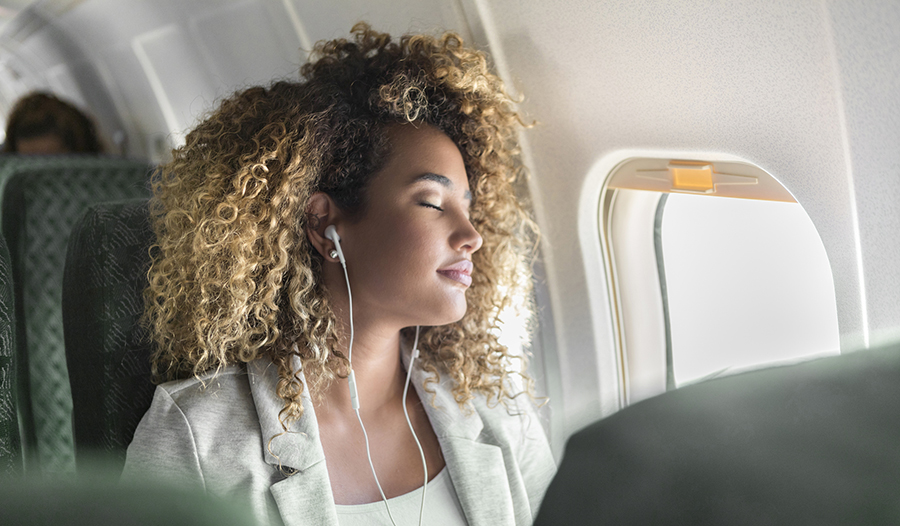10 consigli su come mantenersi in salute durante il volo

Che tu sia in viaggio per lavoro o per piacere, non è divertente ammalarsi una volta arrivati a destinazione. Ecco 10 consigli essenziali da tenere a mente se vuoi evitare di ammalarti la prossima volta che sali su un aereo.
1. Mani pulite
Porta a bordo gel igienizzante o salviette . Il Centers for Disease Control and Prevention raccomanda di utilizzare un disinfettante che contenga almeno il 60% di alcol. Sono disponibili anche prodotti naturali senza sostanze chimiche nocive. È necessario applicare un disinfettante per le mani dopo aver toccato qualsiasi superficie non igienizzata sull'aereo, prima di mangiare o bere e prima che le mani tocchino gli occhi, il naso o la bocca.
Usa il disinfettante per pulire il sedile, la cintura di sicurezza, i braccioli, il tavolino e il centro di intrattenimento touchscreen. I batteri possono sopravvivere diversi giorni dopo essere stati lasciati sulle superfici all'interno di un aereo. Uno studio ha dimostrato che l'E. coli dura fino a 4 giorni, mentre l'MRSA permane per almeno una settimana.
Evita di toccare la tasca del sedile di fronte a te. I disinfettanti non sono molto efficaci sul tessuto della tasca del sedile e le persone tendono a usare queste tasche come cestini per i rifiuti, mettendoci dentro quasi tutto. Gli articoli scartati vanno dai fazzoletti usati ai pannolini sporchi.
È anche una buona idea applicare un disinfettante sulle mani anche dopo essersi lavati nel lavandino dell'aereo. L'acqua del rubinetto a bordo non ha una buona reputazione. Nel 2004, l'Agenzia per la Protezione dell'Ambiente (EPA) ha stabilito che tutti i sistemi idrici pubblici degli aerei non erano conformi alle norme nazionali sull'acqua potabile. Sono stati riscontrati alti livelli di batteri fecali nell'acqua potabile di 15 dei 327 piani analizzati dall'EPA.
Nel 2009, l'agenzia ha creato nuovi regolamenti per i sistemi idrici degli aerei. Tuttavia, lo studio sull'acqua delle compagnie aeree del 2019 ha dimostrato che la qualità dell'acqua potabile varia da una compagnia all'altra e che molte di esse potrebbero aver fornito acqua non salubre ai propri passeggeri.
2. Bevi molta acqua pulita
Data la possibilità di contaminazione dell'acqua, è consigliabile non bere l'acqua fornita a bordo, a meno che non provenga da una lattina o da una bottiglia sigillata. Evita anche il tè o il caffè preparato in aereo. Potresti prendere in considerazione l'idea di portare con te una bottiglia d'acqua vuota riutilizzabilee, dopo aver superato i controlli di sicurezza dell'aeroporto, riempirla presso una fontanella prima dell'imbarco.
Bevi molta acqua a partire da due giorni prima del viaggio e regolarmente per tutta la durata del volo, perché in aereo può essere molto secco - il livello di umidità è spesso inferiore al 20%. Cerca di assumere circa otto once di acqua per ogni ora di navigazione. Quando sei disidratato, le tue membrane mucose si seccano e questo ti rende più vulnerabile alle infezioni virali e batteriche.
La disidratazione può anche causare sintomi fastidiosi come mal di testa, mal di gola, secchezza degli occhi e della pelle. Questi sintomi possono persistere per un bel po' di tempo dopo aver raggiunto la destinazione.
Limita le bevande che contengono caffeina o alcol. A causa dell'effetto diuretico, queste bevande possono essere molto disidratanti. Inoltre, poiché i livelli di ossigeno sono ridotti all'altitudine di crociera, meno ossigeno arriva al cervello e questo aumenta gli effetti dell'alcol che consumi.
3. Usa la bocchetta dell'aria
Gli aerei moderni sono dotati di filtri dell'aria ad alta tecnologia che eliminano il 99,9995% della polvere e dei microbi presenti nell'aria, secondo l'Associazione Internazionale del Trasporto Aereo. Inoltre, l'aria circola solo in una parte dell'abitacolo perché la ventilazione è compartimentata.
Purtroppo, se qualcuno seduto accanto a te starnutisce a causa di un'influenza o di un raffreddore, un agente patogeno potrebbe entrare nelle tue vie respiratorie prima di arrivare al filtro dell'aria. Per combattere questo problema, utilizza la bocchetta dell'aria per eliminare i microbi dal tuo spazio personale. Regola l'aria su un'impostazione media e posiziona la bocchetta in modo che la corrente d'aria passi direttamente davanti alla tua testa. Se metti le mani in grembo, dovresti sentire la corrente lì, non sul viso.
4. Scegli il tuo posto a sedere con saggezza
Optate per un posto al finestrino quando possibile. Il flusso d'aria su un aereo è progettato per scendere dalla parte superiore della cabina e uscire dalle bocchette sul pavimento vicino al finestrino. A causa di questa direzione del flusso d'aria, i passeggeri che siedono al finestrino tendono a essere esposti a un minor numero di microbi trasportati dall'aria rispetto a quelli che siedono nel corridoio.
Se dovessi trovarti seduto vicino a qualcuno che è malato, sappi che alcuni studi hanno rilevato che il rischio di infezione diminuisce al di fuori di una zona di tre file. Ma per essere a rischio di trasmissione respiratoria di un virus devi trovarti a meno di 1-2 file da una persona malata che tossisce attivamente e non agisce per sopprimerla.
Considera anche la possibilità di scegliere un posto a sedere che non sia vicino alla toilette, in quanto tende ad avere persone che si radunano intorno o che passano di frequente. Non è irragionevole sospettare che coloro che passano più tempo in bagno siano quelli che sull'aereo sono già malati.
5. Mangia sano e leggero durante il volo
Stai lontano dai pasti e dagli snack elaborati della compagnia aerea. Cercate insalate e frutta o verdura fresca. Evitare tutti gli alimenti che possono causare gas o gonfiore: mais, fagioli, cipolle o verdure crucifere come cavoli, broccoli e cavolfiori. Limitare i cibi piccanti che possono indurre il reflusso acido. In volo, i gas del corpo si espandono di un terzo e la digestione rallenta.
6. Mantenere la calma
Lo stress può creare scompiglio nel corpo. Prevedete di avere tutto il tempo necessario per raggiungere l'aeroporto. Utilizzate l'opzione di check-in anticipato sul vostro dispositivo mobile il giorno prima del viaggio. Indossate un abbigliamento comodo che non vi crei problemi per superare la fila di sicurezza. Ad esempio, optate per uno strato esterno con cerniera invece di un pullover o di una giacca con bottoni.
7. Riposare a sufficienza
Quando non si dorme a sufficienza si è più soggetti alle malattie, perché il sistema immunitario è indebolito. Dormite almeno 7-8 ore la notte prima del volo. Una goccia di olio di lavanda sulla tempia o sul cuscino al momento di coricarsi può aiutare a rilassarsi e a dormire bene.
Prima del viaggio, modificate il vostro programma di sonno in modo che corrisponda a quello della vostra destinazione. Se viaggiate da ovest a est, dovrete andare a letto prima. Provate a spostare l'ora di andare a letto prima di 30 minuti ogni sera per diverse notti prima di partire.
Se avete problemi ad addormentarvi prima, può essere utile una piccola dose di melatonina (0,5 mg) assunta 90 minuti prima di andare a letto. Tuttavia, non utilizzare la melatonina a lungo termine. Tra i possibili effetti collaterali si annoverano incubi, stordimento diurno e aumento della glicemia. Anche i farmaci per le crisi epilettiche, gli anticoncezionali e l'ipertensione possono essere meno efficaci se assunti con la melatonina, quindi è bene consultare il proprio medico prima di utilizzarla.
8. Spostarsi
Fate un po' di stretching e di esercizi stazionari mentre siete in volo. Questo non solo aiuta ad alleviare la rigidità muscolare che si può avvertire quando si sta seduti in aereo per un lungo periodo, ma può anche prevenire la trombosi venosa profonda. Questa condizione, comunemente chiamata TVP, si verifica quando si forma un coagulo di sangue all'interno di una vena. Il coagulo di sangue può staccarsi e raggiungere i polmoni, dove può diventare pericoloso per la vita.
Il rischio di sviluppare una TVP aumenta se si hanno altri fattori di rischio per i coaguli di sangue, tra cui cancro, obesità, vene varicose, interventi chirurgici recenti, terapia ormonale sostitutiva e età superiore ai 40 anni.
Ecco alcune misure che si possono adottare per prevenire la TVP:
- Muovete le gambe ogni ora. Si può semplicemente stare in piedi per allungare le gambe, raddrizzare le gambe e piegare le caviglie avanti e indietro, oppure portare le ginocchia al petto per 15 secondi e ripetere per 10 serie.
- Evitare di accavallare le gambe.
- Chiedete al vostro medico curante di indossare calze a compressione per favorire la circolazione del sangue se siete a rischio maggiore di TVP.
9. Rafforzare l'immunità
Spesso ci vuole un po' di tempo per sviluppare l'immunità dopo la somministrazione dei vaccini, quindi verificate con il vostro medico curante se il vaccino antinfluenzale o qualsiasi altra vaccinazione per il viaggio sono adatti a voi. Ad esempio, il vaccino contro l'influenza stagionale deve essere somministrato 7-10 giorni prima del viaggio per essere efficace.
Potreste trovare utili anche alcuni integratori:
- La vitamina D ha un ruolo nel rafforzamento del sistema immunitario.
- È stato dimostrato che la vitamina C contribuisce a ridurre la durata dei sintomi del raffreddore.
- I probiotici possono rafforzare il sistema immunitario migliorando la flora intestinale.
10. Aumentare l'assunzione di antiossidanti
I viaggi in aereo espongono a livelli di radiazioni solari e cosmiche leggermente superiori a quelli che si registrano a terra. Aumentare la quantità di alimenti antiossidanti consumati può aiutare a combattere i danni al DNA che l'esposizione alle radiazioni può causare. Infatti, una ricerca sui piloti di linea ha dimostrato che un elevato apporto di antiossidanti con la dieta è associato a una riduzione dei danni al DNA.
I fitonutrienti sono composti prodotti dalle piante e hanno buone proprietà antiossidanti. Esempi di alimenti con fitonutrienti sono noci, semi, agrumi, carote, zucche, broccoli e verdure a foglia verde.
Seguite questi 10 consigli e il vostro prossimo viaggio sarà sano e felice.
ESONERO DI RESPONSABILITÀ:Questo Centro Benessere non intende fornire diagnosi...

















































































 Indice
Indice


